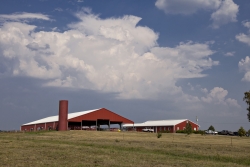Writer Gains New Experiences at Meadowbrook Farm
Cari Tretina, a reporter with the Eastern Progress, visited Meadowbrook Farm and participated in Dr. Laurie Rincker's Reproduction and Artificial Insemination class. "My Turn: Cari Tretina" reflects on her experiences.
Submerged - opposed to experienced - is how I would describe my trip with the reproduction and artificial insemination class to Eastern’s Meadowbrook Farm last Wednesday. This was more than an educational trip, as I am not from Kentucky and have little experience with farm life.
Prior to my adventure to the farm with one of the agriculture department’s classes, Scott Benjamin, agricultural business major, gave me a few pointers in preparation.
“Bring your shit kickers,” Benjamin
said.
My lack of such footwear started my worries.
On the road to our destination, we saw acres of grassy fields filled with barns and various animals. Meadowbrook Farm is comprised of swine, sheep, goats and crops. However, our focus was purely on cows that day.
The smell of manure, freshly chopped grass and hay filled the air underneath the open barn. There were dairy cows in separate stalls to one side, and one beef cow on the other side, also in a stall.
Now, the title of the class alone should inform you of what was taking place. Achieving the goal of this class is not an easy process, though.
In layman’s terms, you place your hand in the anus of the cow and gently insert a small rod with semen into the animal’s vagina.
Even though this sounds horribly graphic and disturbing, the process causes the cow no pain and is a very common practice in the agriculture field. In fact, the students become certified at the end of the course in artificial insemination.
With my very limited experience with cows, I decided observation was the best path for me at the moment. The students seemed to follow protocol to find the cervix, but sometimes it took more than a hand. At one point, one man’s entire arm was inside of the cow.
While Benjamin, his professor, associate professor Laurie Rincker, and director of University Farms Rick Griebenow, prepared me for the actual process, they forgot to mention one side effect it has on the cows-defecation, or poop.
Lots and lots of poop.
Every time a student went to practice the process, poop was involved. Be it a small amount or an entire bowel movement, that glove came out with feces on it. I guess since cows defecate close to 100 pounds in one day it makes sense.
But it is still not normal to a spectator. Observing a situation can only give a person a limited amount of information; I wanted the full experience.
Rincker started preparing me for insertion. I put on the glove, which reached past my shoulder and rubbed lubricant on it. I was about to put my hand in a cow’s rectum.
A glove and some lube was not enough to mentally prepare me.
I approached the cow. For those who don’t know me, I am barely taller than a legal midget and have serious germaphobe issues, so with that said, my head was level with the entrance point and all I could think about was poop.
A deep breath and a little help from Rincker and I was in. My hand slid right through into rather warm, somewhat empty cow innards. I moved my hand, feeling the walls of the colon. As I was soaking this all in, my mind began to concentrate on the amount of sheer feces that
could end up on my body.
Just as that thought crossed my mind, I felt the muscles dilate. Fearing being coated in cow pies, I immediately looked at the professor and said it was time for my hand to come out. My body may have stayed cleaned, but let’s just say that glove wasn’t so lucky.
No amount of hand sanitizer would ever make me feel clean after that experience.
On a more colorful note, during this farm visit I also got to see the milking station. Once again, students and full-time employees alike were in control. About 35 cows get milked twice a day, and these animals produce anywhere from 25 to 45 gallons of milk.
First, the workers guide the cows in front of the milking station.
Unlike in old timey movies, the majority of the milking is done through small, cushioned vacuum tubes. Milking is actually enjoyable to the cows because it releases the pressure from their udders, and most enjoys their yummy products. Meadowbrook Farm supplies some of the
milk for Flav-O-Rich, which is served by Aramark.
When milking begins, the milk must be brought down into the teats, before the machine can be hooked to the cow. Think of a tube of toothpaste. Then the machine is removed and you must double-check the process has been finished by checking the teats, manually.
I, of course, jumped on the opportunity to do both. I was somewhat disappointed I wasn’t sitting on a wooden stool chewing on a piece of straw, but it was still a memorable moment nonetheless.
Since I had never toured a farm, my only preconceptions of farms and dairy productions were the stories I have heard from PETA. Those couldn’t have been farther from the truth. The workers, students and professors look to these creatures not as cash or products but as animals with emotions. Every action a person makes, they also take into consideration the cows’ perspective.
On top of that, the agriculture department teaches and constantly evaluates the students on proper protocol and hygienic procedures. Every animal on that farm has probably the best life of any farm animal.
My trip to Eastern’s farm has probably been one of the greatest and most exciting experiences I have had here in Kentucky, thus far. As an added bonus, I even got a little “hands-in” training.
Read more Eastern Progress Stories...
Published on February 16, 2012
